
Missile base popular with park visitors
HOMESTEAD, Fla.— Within a major national park, filled with mangroves and herons, stood the isolated, secret grounds of national security, where 41-feet long missiles rested and U.S. Army soldiers waited for an attack.
In 1962, the U,S, discovered medium range Soviet missiles in Cuba, just 90 miles from South Florida and, one year later, the U.S. Army Corps of Engineers built four Nike Hercules Missile Base (A Battery) sites, including one in a part of Everglades National Park.
The site was abandoned in 1979, after nuclear threats never materialized.
| Click on the video at right to see an audio slideshow about the historic Nike missile base in the Everglades National Park by writer Elena Schmidt. |
In 2007, Sgt. Charles Carter, who served at the Key Largo site, succeeded in his effort to put the A Battery site on the National Registry of Historic Places. Tours began in 2009 and now, at the end of its second season, its popularity is evident through its thousands of visitors from all over the country.
Carter’s efforts began in 2002 when he visited former missile sites in South Florida; curious about which ones remained.
| While the site is currently void of any missiles, missile barns stored assembled missiles until 1979, capable of far reaching damage and protection of the U.S. (Photo courtesy of Sgt. Charles Carter). | 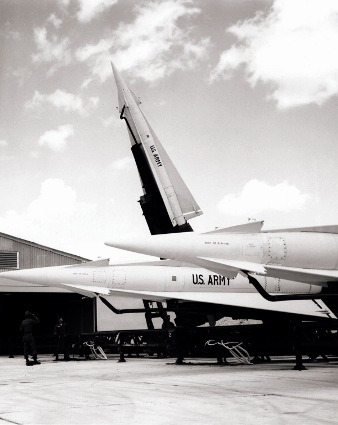 |
“Upon entering [A Battery], everything looked pretty much the same as I had remembered except the offices now were filled with individuals with civilian clothes rather than Army uniforms,” said Carter. “As I visited all of the other Nike sites in South Florida, I found they were pretty much in a state of disrepair.”
While the buildings remained, the site required severe cleaning and preparation before opening it to the public, according to Ryan Meyer, Nike Missile site coordinator for Everglades National Park.
“This is my first year giving the tours. As we do more tours, we meet more veterans and get more stories. It’s taking on a life of its own and we’re connecting with more people all the time,” said Meyer.
For Meyer, the tour’s popularity derives mostly from history buffs and war veterans who served in South Florida. Visitors are eager to experience or reconnect to a critical time in American history.
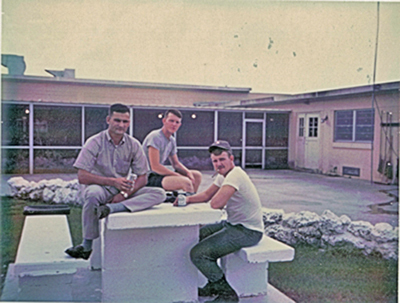 |
While on break soldiers enjoyed a bite to eat and a smoke from the Post Exchange (Photo courtesy of Sgt. Charles Carter). |
Veterans, such as Henry Plehn, from the Second Battalion in South Florida, openly recount their time on the base, where they worked to deter a potential attack.
“We received all the parts to put a missile together and after we put it together, we tested it and got it ready to fire if it was ever needed to be used,” said Plehn who worked as the battalion missile warrant officer.
Plehn was stationed on the site in 1978, long after the soldiers slept in tents at the ENP. For Phlehn and many of the veterans who served post-1965, the permanent structures that withstood Miami’s torrential downpours were taken for granted.
Though isolated from the city, the men at Battery A formed their own community of sorts. The men shopped for necessities at the Post Exchange, got their haircut at the barber shop, and played basketball on the courts.
| Visitors walked up to the doorstep of the bunker, where soldiers remained when missiles were raised (Photos by Elena Schmidt). | 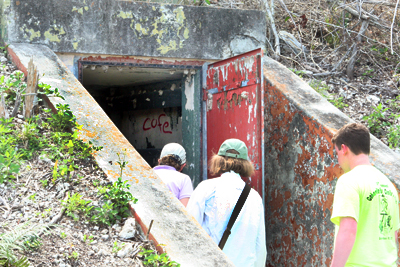 |
Rich Strang, who maintained the spare parts for the missiles and fire control area for A battery recalled many memories of life on base.
“Our Capt. Seagraves threw a party for the battery. He called American Airlines and they sent to the battery a bus load of stewardesses. Attendance was mandatory till 9 p.m., at which time the married men could go home,” said Strang.
While on duty, the men enjoyed their down time until they received “hot status.”
“Five minute [status] was the most critical. If there was something going on in the world and there was a danger involved, something could happen, they would call us at least 15 minutes [status],” said Bill Price, former Chief Warrant Officer.
In less than 15 minutes, six men could disarm and launch the missiles if needed.
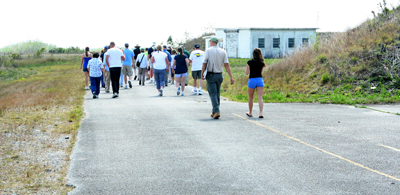 |
Following the peek into the bunker, visitors leave the site, taking one last look at the historic buildings that surround them. |
Luckily, they didn’t have to and the lack of threat caused the site’s eventual termination.
South Florida’s mosquitoes posed a greater threat to the men who were always armed with repellant.
The missiles and radar systems were removed, but the Integrated Fire Control Area, missile barns, barracks, bunker and dog kennel remain for our educational benefit.
According to Meyer, the site as it stands is a work in progress. A recent report will look into the history of the site and consulting firms will help restore the site closer its original appearance over the coming years.
For next December when the tour season opens again, Meyer hopes to have the administration building painted back to its original hot pink shade and potentially open up another missile assembly building and bunker room for viewing.
| The first of three missile barns, and the only one open to the tour, holds the original warning sign that stood outside the exclusionary fence. | 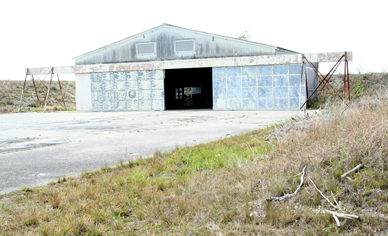 |
“Besides conservation of the site, we are hoping to gather some interpretative props; put some of the old equipment back in,” said Meyer.
For now people are enjoying the site as it stands and the personal stories they hear, the parts of the base that make it human said Meyer.
“We don’t have mountains, we don’t have vistas, but we have the biology, birds and alligators,” said Meyer. “Now we have something completely different, a historic site, which really adds to the richness of the park,” said Meyer.
If You Go:
Tour Season: Mid December – April.
Tour Days and Times: Mondays through Fridays, 10 a.m. – 11:30 a.m.
Saturdays and Sundays, 2 p.m. – 3:30 p.m.
Fees: Free tour with park entrance fee: $10 per vehicle.
Directions: Dan Beard Research Center: Seven miles from Ernest Coe Visitor Center, 40001 State Road 9336 Homestead, FL 33034-6733.

Comments are Closed